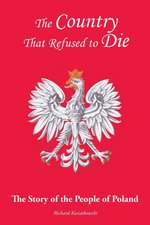Making Disability Modern: Design Histories
Editat de Bess Williamson, Elizabeth Guffeyen Limba Engleză Paperback – 19 aug 2020
Preț: 161.32 lei
Preț vechi: 174.37 lei
-7% Nou
Puncte Express: 242
Preț estimativ în valută:
30.87€ • 32.34$ • 25.52£
30.87€ • 32.34$ • 25.52£
Carte tipărită la comandă
Livrare economică 12-26 aprilie
Livrare express 08-14 martie pentru 40.80 lei
Preluare comenzi: 021 569.72.76
Specificații
ISBN-13: 9781350070424
ISBN-10: 1350070424
Pagini: 264
Ilustrații: 20 bw illus
Dimensiuni: 156 x 234 x 17 mm
Greutate: 0.43 kg
Editura: Bloomsbury Publishing
Colecția Bloomsbury Visual Arts
Locul publicării:London, United Kingdom
ISBN-10: 1350070424
Pagini: 264
Ilustrații: 20 bw illus
Dimensiuni: 156 x 234 x 17 mm
Greutate: 0.43 kg
Editura: Bloomsbury Publishing
Colecția Bloomsbury Visual Arts
Locul publicării:London, United Kingdom
Caracteristici
An innovative volume addressing a hot topic within design and disability studies - the role of designed objects and spaces.
Notă biografică
Elizabeth Guffey is Professor of Art and Design History at Purchase College, State University of New York, USA, where she also heads the MA in Modern and Contemporary Art. She is the author of Designing Disability: Symbols, Space, and Society (Bloomsbury, 2017), Posters: A Global History (2014), and Retro: The Culture of Revival (2002).Bess Williamson is Associate Professor of Design History at the School of the Art Institute of Chicago, where she teaches courses on modern and contemporary design in relation to politics and social change. Her book, Accessible America: A History of Disability and Design (2019), describes the role of design in the US Disability Rights cause of the last half of the 20th century.
Cuprins
AcknowledgmentsIntroduction: Rethinking Design History through Disability, Rethinking Disability through DesignElizabeth Guffey and Bess Williamson, School of the Art Institute of Chicago, USASection I: Designers and Users From Craft to IndustryIntroduction1. The Material Culture of Gout in Early America, Nicole Belolan (Rutgers University, USA)2. Walking Cane Style and Medicalized Mobility, Cara Kiernan Fallon (University of Pennsylvania, USA)3. Artificial Limbs on the Panama Canal, Caroline Lieffers (Yale University, USA)4. Technologies for the Deaf in British India, 1850-1950, Aparna Nair (University of Oklahoma, USA) Section II: Disability and World-Making in the Twentieth CenturyIntroduction5. The Ideologies of Designing for Disability, Elizabeth Guffey (Purdue University, USA)6. Architecture, Science, and Disabled Citizenship, Wanda Katja Liebermann (Florida Atlantic University, USA)7. Disability and Modern Chemical Sensitivities, Debra Riley Parr (Columbia College Chicago, USA)8. Design for Deaf Education: An Early History of the National Technical Institute for the Deaf, Kristoffer Whitney (Rochester Institute of Technology, USA)9. Designing the Japanese Walking Bag, Elizabeth Guffey (Purdue University, USA) Section III: Making Disability DigitalIntroduction10. The Politics and Logistics of Ergonomic Design, Jennifer Kaufmann-Buhler (Purdue University, USA)11. Designing Emergency Access: Lifeline & LifeCall, Elizabeth Ellcessor (University of Virginia, USA)12. 3D Printed Prosthetics and the Uses of Design, Bess Williamson (School of the Art Institute of Chicago, USA)13. Materializing User Identities and Digital Humanities, Jaipreet Virdi (University of Delaware, USA)
Recenzii
Making Disability Modern makes a good reader that maps out the areas of tension, new discourse, and discussion points about design and disability from practical, social, cultural, and technological perspectives.
This book makes visible often-obscured aspects of human life, the built environment, and societal factors that materialize through design, disability, and their intersections over history and across continents.
A fascinating collection of critical cultural histories of disability objects, woven together with a narrative of 'the modern' and its connotations in society, industry and design. We need more books like this to connect disability studies and design.
At last! Since the publication in 2002 of the groundbreaking anthology, Artificial Parts, Practical Lives: Modern Histories of Prosthetics (NYU Press), scholarship has boomed at the intersection of disability studies and the history of technology. This new collection from Bloomsbury brings readers up to date with developments in the field, revising familiar historical throughlines with an original "design model of disability." Rather than situate disability outside modernism, with its predilection for clean lines and average bodies, the authors in Making Disability Modern rethink "dismodern" design and the modern ambitions of disabled designers themselves.
This book makes visible often-obscured aspects of human life, the built environment, and societal factors that materialize through design, disability, and their intersections over history and across continents.
A fascinating collection of critical cultural histories of disability objects, woven together with a narrative of 'the modern' and its connotations in society, industry and design. We need more books like this to connect disability studies and design.
At last! Since the publication in 2002 of the groundbreaking anthology, Artificial Parts, Practical Lives: Modern Histories of Prosthetics (NYU Press), scholarship has boomed at the intersection of disability studies and the history of technology. This new collection from Bloomsbury brings readers up to date with developments in the field, revising familiar historical throughlines with an original "design model of disability." Rather than situate disability outside modernism, with its predilection for clean lines and average bodies, the authors in Making Disability Modern rethink "dismodern" design and the modern ambitions of disabled designers themselves.












